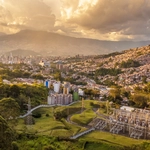The city's origins
Bogotá's roots lie in the Muisca civilization, an indigenous culture that flourished in the region long before the arrival of European settlers. Remains of this civilization persist, reminding us of the city's rich history. However, it was in the 16th century that Bogotá was officially founded, marking the beginning of an era of development and Spanish influence that forged its unique character.

People and culture
Bogotá's inhabitants, the Bogotanos, embody Colombian warmth and pride. The city's vibrant culture is evident in its colorful festivals, lively dances and delicious cuisine. Bogotá also serves as an artistic cradle, with a thriving scene of museums, galleries and theaters. This cultural diversity creates a dynamic social fabric, where past and present blend harmoniously.

Climate and geography
Located at an altitude of 2,640 meters, Bogotá offers a unique mountain climate. Moderate temperatures throughout the year make it an attractive destination. However, visitors should be prepared to be surprised by the occasional downpour, which adds a touch of mystery to the city's already electric atmosphere. The surrounding mountains and verdant valleys add to the region's natural splendor.

Population and urban dynamism
With a population of over seven million, Bogotá is the beating heart of Colombia. Historic districts such as La Candelaria bear witness to colonial history, while modern districts like Chapinero embody economic growth and urban diversity. This juxtaposition creates a dynamic urban experience, where each street tells a different story.

Conclusion
Bogotá, with its fascinating blend of history, culture and landscape, is a must-see destination. Through its lively streets, diverse neighborhoods and rich heritage, the Colombian capital offers an invitation to explore the very soul of Colombia. Bogotá, a symphony of culture and contrasts, continues to seduce travelers from all over the world, taking them on an unforgettable adventure to the heart of South America.


